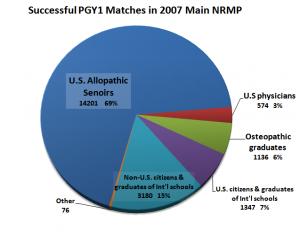What Is This “Match” Thing, Anyway?

First off – I’m back from blogging maternity leave – celebration dances may commence! Oh, you thought you got rid of me because I birthed two babies at one time? Oh no, friends, it won’t be nearly that easy to get rid of me.
Now, for our regularly scheduled post of insightful information.
If I had a dollar for every time someone has asked me “hey you did all those interviews (while ridiculously huge and pregnant), did you get a job yet?” I’d probably have 14 pesos by now. Nobody outside of medicine understands how this works…and quite honestly, I can’t imagine why they would want to…but I’m going to try to break it down into simple bullets as well as I can. This is an extremely basic overview.
Applying To Residency – The Basics
- Medical school is four years long.
- Sometime during the third year most people choose a specialty. I chose Ob/Gyn.
- In the Fall semester of your fourth year residency applications are due.
- Some specialties have different application processes, this blog discusses the most common.
Interviewing For Residency Positions
- After applications are in programs offer interviews.
- Interview season is generally from September – January of fourth year.
- People do an average of 10 interviews, depending on competitiveness.
Applicants Make A “Rank List”
- After all interviews are completed we rank each place we interviewed based on how badly we would like to go there. I interviewed 10 places and ranked 7 – you’re allowed to leave any places you don’t think you’d want to go off your list and this guarantees you won’t end up there.
- Rank lists this year were due February 20, 2013. (yesterday! eek!!)
Programs Make A “Rank List”
- Programs rank applicants who interviewed according to how badly they want them to join their program. Like applicants, programs are allowed to choose not to rank a certain person if they really don’t think they’re a good fit for the program.
- A very large, Alien-manned computer located somewhere between here and Venus uses a mysterious, Big Bang Theory-type algorithm to calculate where an applicant will “match.”
- This pairing goes in favor of the applicant – so applicants get matched to the highest place on their list that also ranked them.
- The idea is to put the largest number of applicants possible at the programs they really liked. This is the extent of my understanding. If you’d like the nitty gritty on how the actual algorithm works you can read about it here.
- The Monday before Match Day applicants find out if they matched. Applicants who don’t match enter into the Supplemental Offer Acceptance Program (SOAP), that’s a whole blog post in itself.
Match Day – March 15, 2013
- MATCH DAY! Friday you gather with your classmates for a big, fancy ceremony and celebration. At our school we have an exciting morning filled with friends and food. Everyone gets an envelope with their name on the outside and destiny on the inside. At 11am we all open them together to find out where we will be spending the next 3-7 years. Obviously, everyone hopes for their #1 choice, but most people are happy with any of their top 3 or 4.
So, no I haven’t technically gotten a job from all those interviews I did…yet! I will find out on Monday, March 11 IF I got a job and Friday, March 15 WHERE I got a job.
There, clear as mud…now how should I spend all these pesos?
